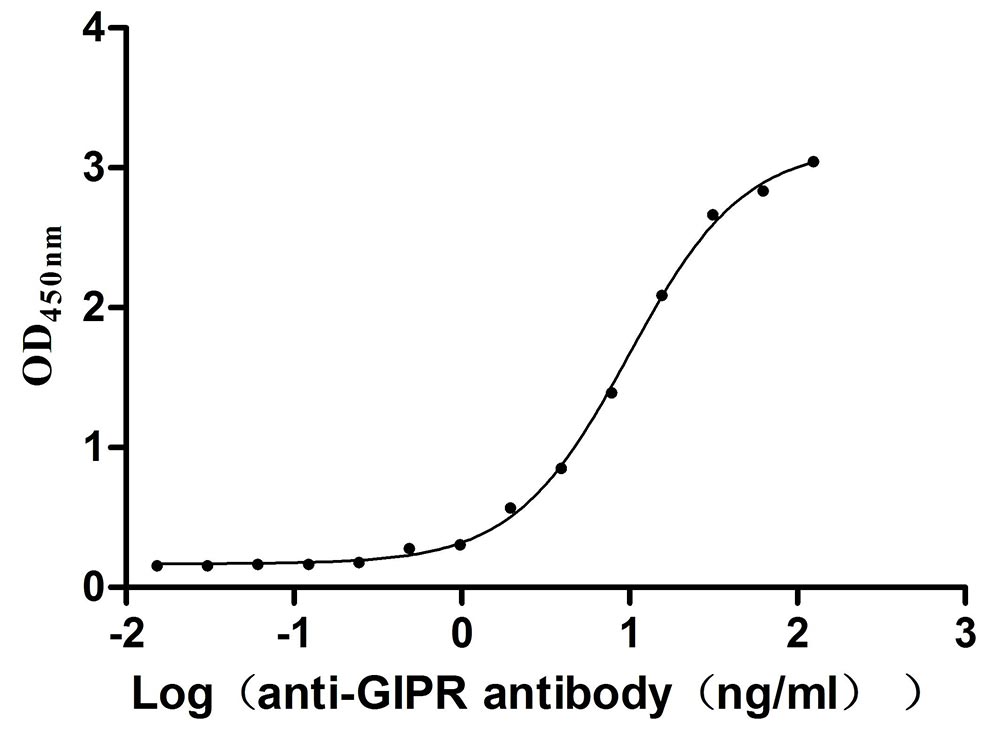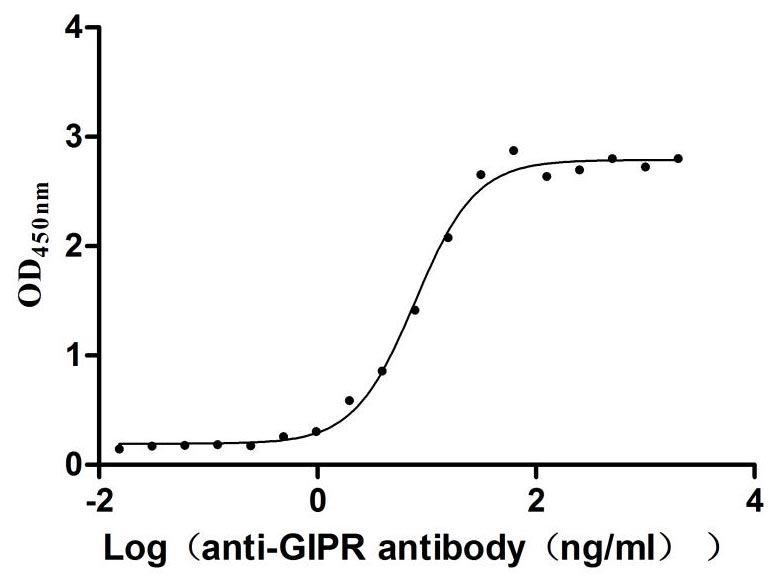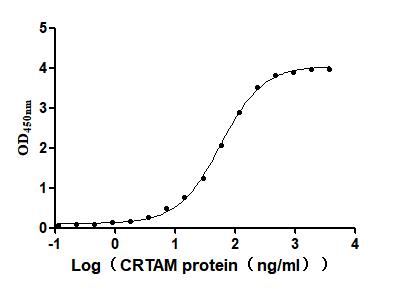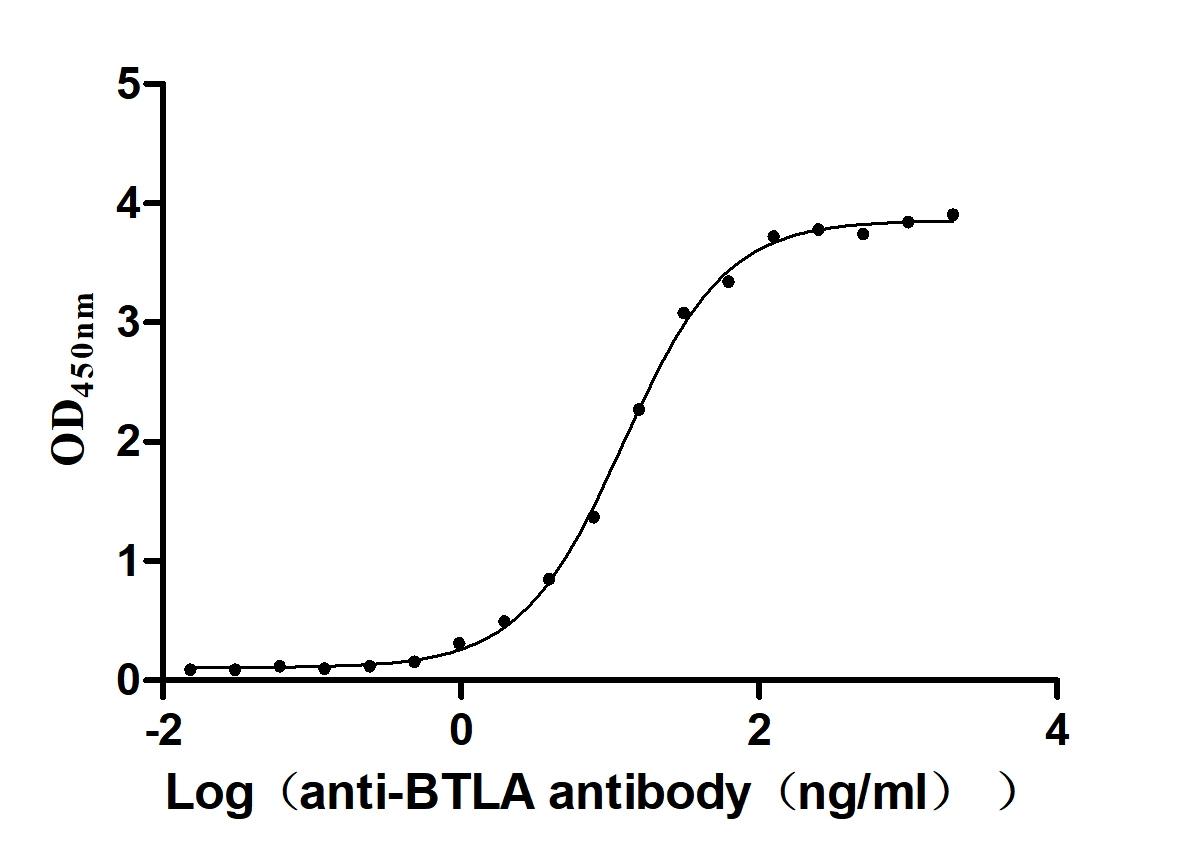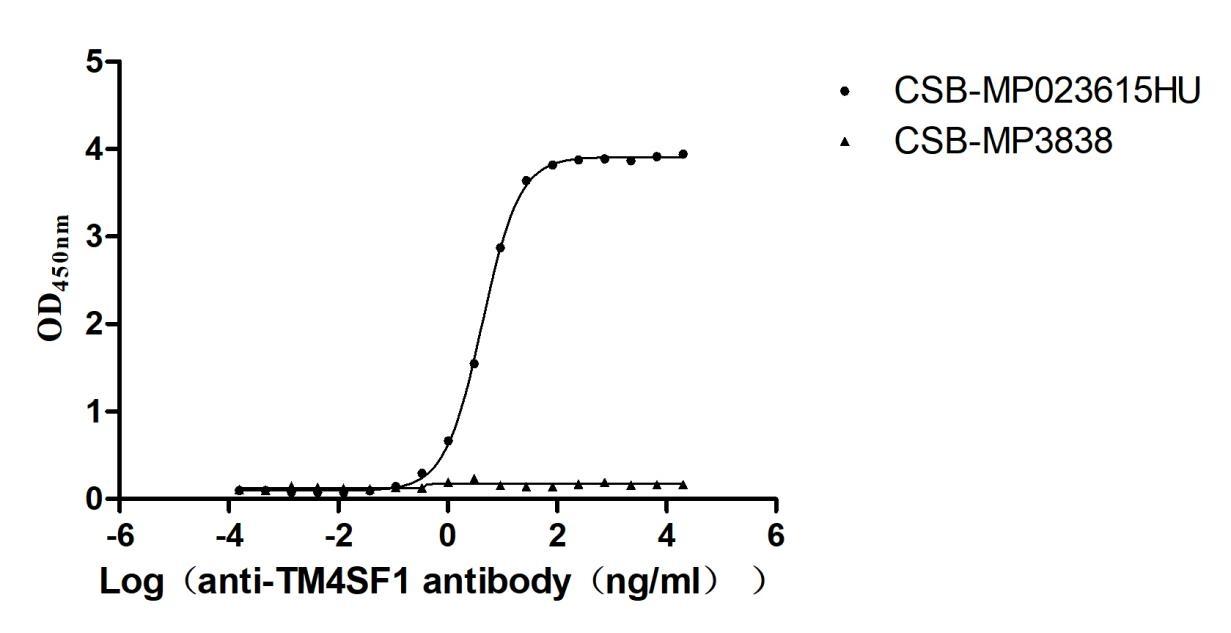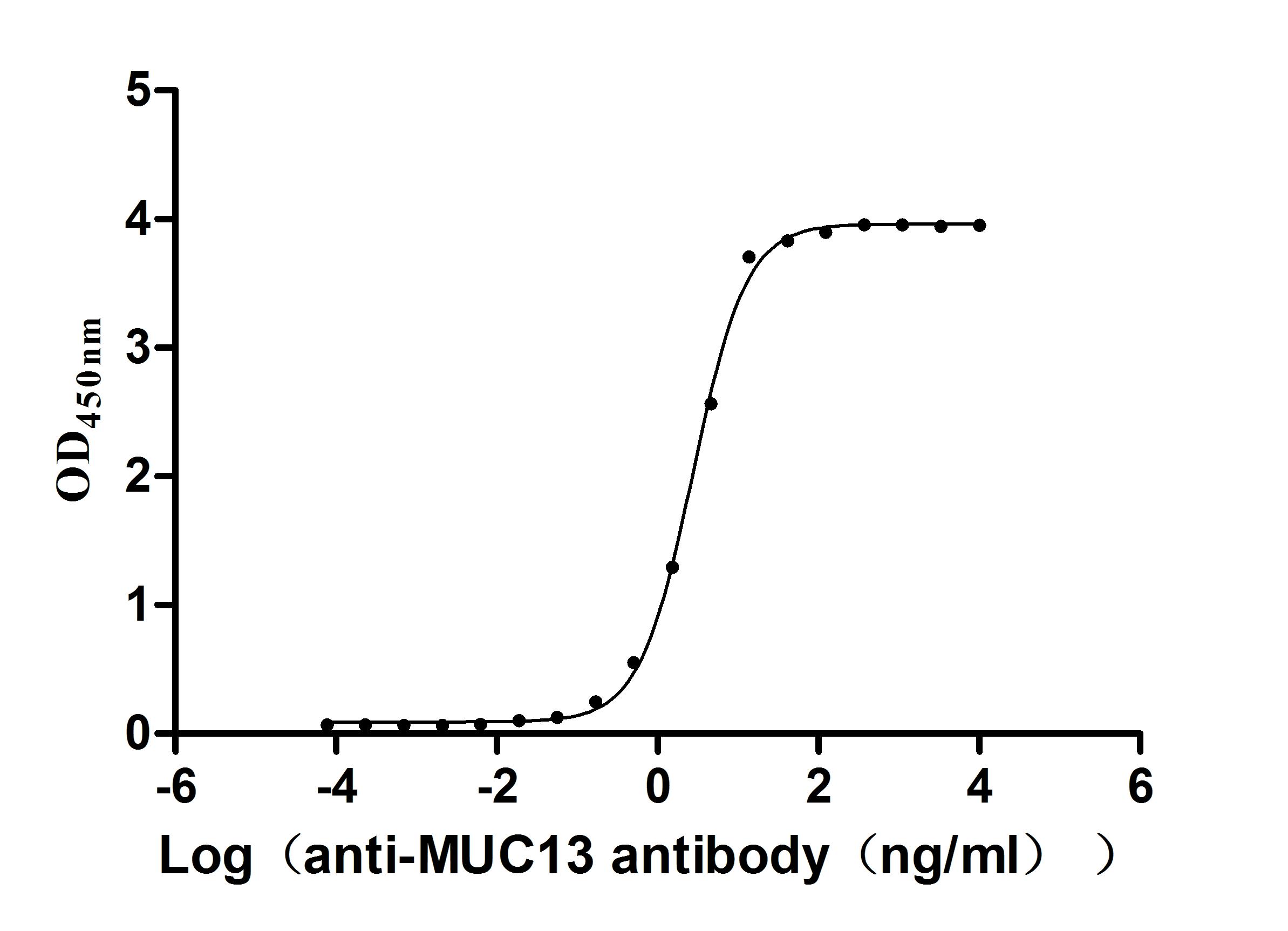Recombinant Human Atypical chemokine receptor 3 (ACKR3)-VLPs
-
中文名稱:Recombinant Human Atypical chemokine receptor 3(ACKR3)
-
貨號:CSB-MP006257HU(A4)
-
規(guī)格:
-
其他:
產(chǎn)品詳情
-
基因名:
-
Uniprot No.:
-
別名:ACKR3; CMKOR1; CXCR7; GPR159; RDC1; Atypical chemokine receptor 3; C-X-C chemokine receptor type 7; CXC-R7; CXCR-7; Chemokine orphan receptor 1; G-protein coupled receptor 159; G-protein coupled receptor RDC1 homolog; RDC-1
-
種屬:Homo sapiens (Human)
-
來源:Mammalian cell
-
表達區(qū)域:1-362aa
-
氨基酸序列MDLHLFDYSEPGNFSDISWPCNSSDCIVVDTVMCPNMPNKSVLLYTLSFIYIFIFVIGMIANSVVVWVNIQAKTTGYDTHCYILNLAIADLWVVLTIPVWVVSLVQHNQWPMGELTCKVTHLIFSINLFGSIFFLTCMSVDRYLSITYFTNTPSSRKKMVRRVVCILVWLLAFCVSLPDTYYLKTVTSASNNETYCRSFYPEHSIKEWLIGMELVSVVLGFAVPFSIIAVFYFLLARAISASSDQEKHSSRKIIFSYVVVFLVCWLPYHVAVLLDIFSILHYIPFTCRLEHALFTALHVTQCLSLVHCCVNPVLYSFINRNYRYELMKAFIFKYSAKTGLTKLIDASRVSETEYSALEQSTK
Note: The complete sequence including tag sequence, target protein sequence and linker sequence could be provided upon request. -
蛋白標簽:C-terminal 10xHis-tagged
If you have specified tag type, please tell us and we will check if it’s possible to develop. -
產(chǎn)品提供形式:Lyophilized powder
Note: We will default ship it in lyophilized form with normal bule ice packs. However, if you request to ship in liquid form, it needs to be shipped with dry ice, please communicate with us in advance and extra fees for dry ice and dry ice box will be charged. -
緩沖液:Lyophilized from PBS, 6% Trehalose, pH 7.4
-
儲存條件:Store at -20°C/-80°C upon receipt, aliquoting is necessary for mutiple use. Avoid repeated freeze-thaw cycles.
-
保質(zhì)期:The shelf life is related to many factors, storage state, buffer ingredients, storage temperature and the stability of the protein itself.
Generally, the shelf life of liquid form is 6 months at -20°C/-80°C. The shelf life of lyophilized form is 12 months at -20°C/-80°C. -
貨期:Delivery time may differ from different purchasing way or location, please kindly consult your local distributors for specific delivery time.
Note: Delivery time may differ from different purchasing way or location, please kindly consult your local distributors for specific delivery time. -
注意事項:Repeated freezing and thawing is not recommended. Store the protein at -20°C/-80°C upon receiving it, and ensure to avoid repeated freezing and thawing, otherwise, it will affect the protein activity.
-
Datasheet & COA:Please contact us to get it.
相關產(chǎn)品
靶點詳情
-
功能:Atypical chemokine receptor that controls chemokine levels and localization via high-affinity chemokine binding that is uncoupled from classic ligand-driven signal transduction cascades, resulting instead in chemokine sequestration, degradation, or transcytosis. Also known as interceptor (internalizing receptor) or chemokine-scavenging receptor or chemokine decoy receptor. Acts as a receptor for chemokines CXCL11 and CXCL12/SDF1. Chemokine binding does not activate G-protein-mediated signal transduction but instead induces beta-arrestin recruitment, leading to ligand internalization and activation of MAPK signaling pathway. Required for regulation of CXCR4 protein levels in migrating interneurons, thereby adapting their chemokine responsiveness. In glioma cells, transduces signals via MEK/ERK pathway, mediating resistance to apoptosis. Promotes cell growth and survival. Not involved in cell migration, adhesion or proliferation of normal hematopoietic progenitors but activated by CXCL11 in malignant hemapoietic cells, leading to phosphorylation of ERK1/2 (MAPK3/MAPK1) and enhanced cell adhesion and migration. Plays a regulatory role in CXCR4-mediated activation of cell surface integrins by CXCL12. Required for heart valve development. Acts as coreceptor with CXCR4 for a restricted number of HIV isolates.
-
基因功能參考文獻:
- this study shows an essential role of CXCR7, together with CXCR4, in the control of normal and malignant hematopoietic cell migration and homing induced by CXCL12. PMID: 29433559
- Expression of CXCR7 associates with increased survival in CXCR4+ but not in CXCR4- DLBCL patients. CXCR7 overexpression in vitro is able to diminish DLBCL cell survival and increase their sensitivity to antitumor drugs. PMID: 29920526
- Residues 2-6 of ACKR3 form an antiparallel beta-sheet with the beta1 strand (residues 25-29) of CXCL12. PMID: 28098154
- These findings suggest that the manipulation of miR-539-5p/CXCR7 levels may have important therapeutic implications in choroidal neovascularization-associated diseases PMID: 29146732
- CXCR7 is an oncogene in PCa that can promote aggressive progression of PCa through enhancing proliferation and migration of the tumor cells. PMID: 30047547
- Study shows that overexpression of CXCR7 in different cellular populations of endometriosis microenvironment may play a role in the pathogenesis and represent a novel target for treatment. PMID: 29587613
- CXCR7 silencing inhibits the migration and invasion of human tumor endothelial cells derived from hepatocellular carcinoma by suppressing STAT3. PMID: 29901083
- Hetero-oligomerization of a1B/D-adrenergic receptor with the chemokine (C-X-C motif) receptor 4:atypical chemokine receptor 3 heteromeric complex is required for a1B/Dadrenergic receptor function PMID: 28862946
- This work demonstrates distinct roles for the SDF-1/CXCR4 or CXCR7 network in human induced pluripotent stem cell-derived ventricular cardiomyocyte specification, maturation and function. PMID: 28711757
- A role for CXCR7 in bladder cancer [review] PMID: 29022185
- CXCR7-small hairpin RNA inhibits tumour invasion and metastasis. PMID: 28429395
- Chemokine receptor CXCR7 may involve in the clinical glioblastoma (GBM) progression, and CXCR7 could be a valuable prognostic marker in the treatment of GBM. PMID: 28759950
- Therefore, CXCR7 may be associated with peritoneal metastasis in gastric cancer. PMID: 27941339
- CXCL12-CXCR7 axis accelerates migration and invasion of pancreatic cancer cells through mTOR and Rho/ROCK pathways, and predicts poor prognosis of pancreatic cancer PMID: 27542220
- The CXCR7/CXCL12 axis is involved in lymph node and liver metastasis of gastric cancer. PMID: 28533662
- Among 479 individuals affected with clear cell renal cell carcinoma, only synonymous variants were found in COPS8 and one of the missense variants in ACKR3:c.892C>T, was observed in 4/479 individuals screened PMID: 28063109
- Results show that CXCR7 is highly expressed in metastatic lymph node (MNL) of non-small cell lung neoplasm (NSCLC) and is associated with poor prognosis. PMID: 29032612
- While the potencies of all proteins in ACKR3 Presto-Tango assays were comparable, the efficacy of CXCL12(3-68) to activate ACKR3 was significantly reduced PMID: 29125867
- CXCR7 mediates CD14(+)CD16(+) monocyte transmigration across the blood brain barrier, and is a potential therapeutic target for neuro AIDS. PMID: 28754798
- CXCR7 signaling could not be detected using impedance measurements. However, increasing levels of CXCR7 expression significantly reduced the CXCR4-mediated impedance readout, suggesting a regulatory role for CXCR7 on CXCR4-mediated signaling. PMID: 28945785
- CXCR7 expression in gastric cancer tissues was significantly higher than that in adjacent non-cancer tissues and associated with tumor size, TNM stage and lymph node metastasis. CXCR7 was identified as a novel promoter in gastric cancer initiation and progression. PMID: 28281844
- the data identified the pivotal role of the receptor CXCR7 in pulmonary inflammation with a predominant effect on the pulmonary epithelium and polymorphonuclear neutrophils PMID: 28188248
- SDF-1/CXCR7 plays a positive role in the proliferation and invasion of endometrial carcinoma cells. PMID: 28239742
- our study demonstrates that the upregulation of CXCR7 signaling contributes to increased vasculogenic capacity of EOCs from CAD patients, indicating that CXCR7 signaling may be a novel therapeutic vasculogenic target for CAD. PMID: 27612090
- CXCR7 expression in the tumor cells and stromal cells from the metastatic foci was significantly more common in the group of male patients treated with cytotoxic drugs according to the FOLFOX6 regimen PMID: 28295006
- hypoxia and CXCL12-CXCR7 axis appeared to be advantageous microenvironments to CD20(-) CD138(-) cells in lymphoplasmacytic lymphoma PMID: 26878134
- suppressing CXCR4 is not enough to impede osteosarcoma invasion in bone marrow microenvironment since CXCR7 is activated to sustain invasion. Therefore, inhibiting both CXCR4 and CXCR7 could be a promising strategy in controlling osteosarcoma invasion. PMID: 28468584
- This short review intends to provide a concise summary of current knowledge with regards to cell-specific functions of CXCL12 and its receptors CXCR4 and CXCR7 with potential implications for the initiation and progression of atherosclerosis. [review] PMID: 25586789
- CXCR7 overexpression is associated with gastric cancer. PMID: 27716367
- CXCL12 may be an effective diagnostic marker for papillary thyroid carcinoma, and CXCL12/CXCR4/CXCR7 axis may contribute to thyroid cancer development by regulating cancer cell migration and invasion via AKT and ERK signaling and MMP-2 activation. PMID: 27082011
- Our study suggested that CXCR7 plays an important proangiogenic role in hepatocellular carcinoma (HCC). via activation of the AKT pathway. So CXCR7 may be a potential target for antiangiogenic therapy in HCC PMID: 27572688
- CXCR7 is a direct downstream target of miR-100, and overexpression of miR-100 efficiently suppresses CXCR7 expression. PMID: 27035873
- Overexpression of CXCR7 is associated with breast cancer. PMID: 27460092
- High CXCR7 expression is associated with endometrial cancer. PMID: 26678890
- the current study revealed that CXCL12 which combined its receptors CXCR4 and CXCR7 together could promote cell migration and cell invasion of OSCC. PMID: 26232325
- Increased CXCR7 expression is associated with invasion in nasopharyngeal carcinoma. PMID: 26715277
- Up-regulation of miR-218 expression in renal cell carcinoma under hypoxia can result in significant and targeted down-regulation of CXCR7 expression. PMID: 27133059
- CXCR7 affects the growth of PTC cells. PMID: 26383519
- CXCR7 may play a role in the progression, metastasis and angiogenesis of otorhinolaryngologic tumours. PMID: 26996902
- CXCR4 was co-expressed with all investigated neural and embryonic stem cell markers in both primary and recurrent tissues, whereas CXCR7 was mostly found on stem cell marker-negative cells, but was co-expressed with KLF-4 on a distinct GBM cell subpopulation PMID: 26821357
- Expression levels of CXCR4 and CXCR7 in breast cancer tissues were significantly higher than that in adjacent normal tissues and patients with high CXCR4 and CXCR7 expression had a shorter survival time compared with those with low expression. PMID: 26722521
- Data shows the relative expression of CXCR4 and CXCR7 in platelets, their dynamic trafficking, how they differentially mediate the functional and survival response to some chemokines, and their prognostic value in coronary artery disease. [review] PMID: 26551719
- CXCR7 expression in colorectal carcinoma was correlated with tumor development and poor prognosis of patients. PMID: 26722500
- TGFbeta1-CXCR7 axis may be a prognostic marker and may provide novel targets for combinational therapies to be used in the treatment of advanced lung cancer in the future PMID: 26212008
- Evidences suggest an indispensable role of GLI1 in the migration and metastasis of breast cancer cells through CXCL12/CXCR4 signaling enhancement. PMID: 26413813
- Developmental expression patterns of chemokines CXCL11, CXCL12 and their receptor CXCR7 in testes PMID: 25810367
- STAT3 signaling downstream of CXCR7 is involved in miR-101 regulation of breast cancer cell behaviors. PMID: 26360780
- CXCR7 is expressed on NogoA- and Nkx2.2-positive oligodendroglial cells in human multiple sclerosis brains. PMID: 26741980
- This study found that elevated mRNA levels for CXCR7 (+29%; p<.0001) and CXCR4 (+14%, p=.052) in schizophrenia subjects. PMID: 25464914
- the roles of CXCR4, CXCR7, and CXCL12 are associated with trophoblastic cells apoptosis and may be linked to the occurrence and development of severe preeclampsia PMID: 26721717
顯示更多
收起更多
-
亞細胞定位:Cell membrane; Multi-pass membrane protein. Cytoplasm, perinuclear region. Early endosome. Recycling endosome. Note=Predominantly localizes to endocytic vesicles, and upon stimulation by the ligand is internalized via clathrin-coated pits in a beta-arrestin-dependent manner. Once internalized, the ligand dissociates from the receptor, and is targeted to degradation while the receptor is recycled back to the cell membrane.
-
蛋白家族:G-protein coupled receptor 1 family, Atypical chemokine receptor subfamily
-
組織特異性:Expressed in monocytes, basophils, B-cells, umbilical vein endothelial cells (HUVEC) and B-lymphoblastoid cells. Lower expression detected in CD4+ T-lymphocytes and natural killer cells. In the brain, detected in endothelial cells and capillaries, and in
-
數(shù)據(jù)庫鏈接:
Most popular with customers
-
Recombinant Human Tumor necrosis factor receptor superfamily member 11B (TNFRSF11B) (Active)
Express system: Mammalian cell
Species: Homo sapiens (Human)
-
Recombinant Mouse Gastric inhibitory polypeptide receptor (Gipr), partial (Active)
Express system: Mammalian cell
Species: Mus musculus (Mouse)
-
Recombinant Rat Gastric inhibitory polypeptide receptor (Gipr), partial (Active)
Express system: Mammalian cell
Species: Rattus norvegicus (Rat)
-
Recombinant Mouse Cytotoxic and regulatory T-cell molecule (Crtam), partial (Active)
Express system: Mammalian cell
Species: Mus musculus (Mouse)
-
Recombinant Human B- and T-lymphocyte attenuator(BTLA), partial (Active)
Express system: Mammalian cell
Species: Homo sapiens (Human)
-
Recombinant Human Transmembrane 4 L6 family member 1(TM4SF1)-VLPs (Active)
Express system: Mammalian cell
Species: Homo sapiens (Human)
-
Recombinant Human Mucin-13(MUC13),partial (Active)
Express system: yeast
Species: Homo sapiens (Human)



